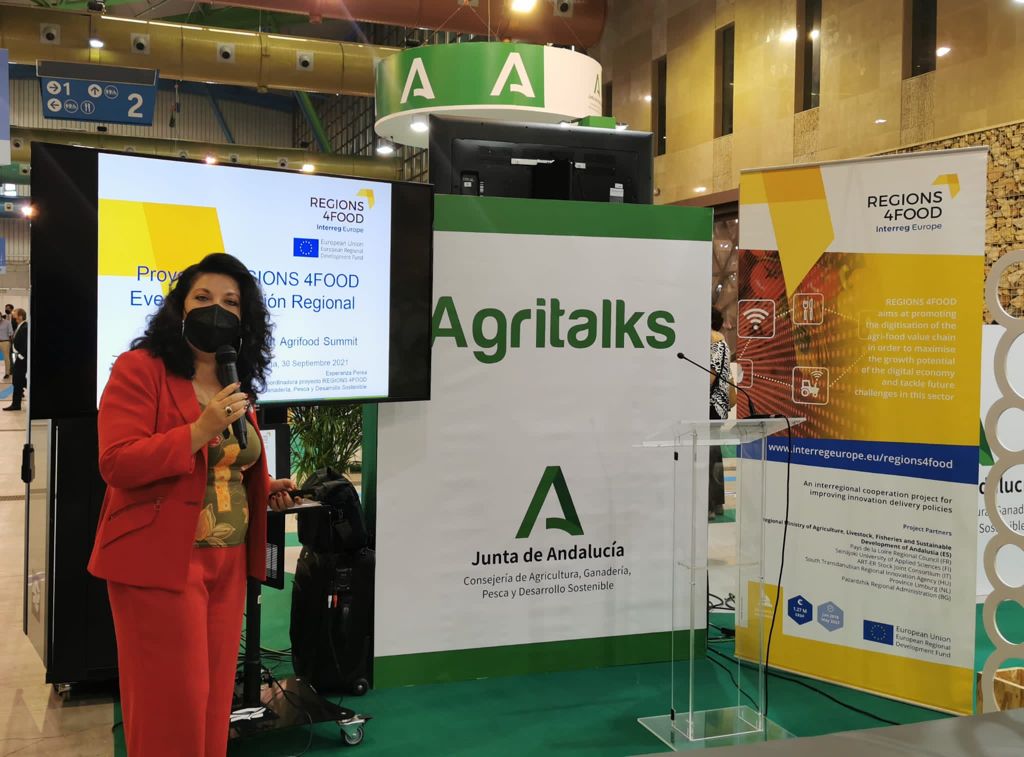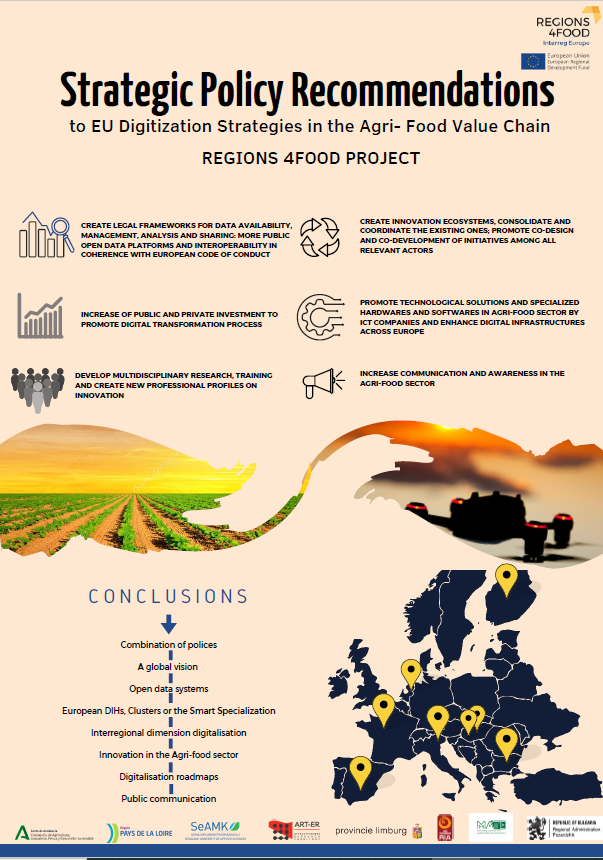South Ostrobothnia: Action plan results
Useful insights from Action Plan implementation in South Ostrobothnia
Data has become a key asset for the food industry which is leading to innovations in technology and the development of new tools and skills.
However, the large volume and diverse nature of food value chains data and actors call for specific integration and management procedures to make the most of new economic opportunities based on information, data and cognitive technologies and promote innovation-driven growth.
For this purpose, 7 regions have decided to join efforts to face new challenges by developing an exchange of experience approach and work plan which allow them to create synergies and opportunities by identifying good practice implemented in other territories.
Partners will work in close cooperation with stakeholders to interconnect regional innovation ecosystems. Best practices for each region will be integrated in their action plans in order to improve the targeted policy instruments governance or to implement projects that will contribute to achieving the above-mentioned goal.
• 7 action plans to improve policy instruments selected by project partners according to their relevance in terms of better exploiting ICT’s potential and deliver innovation to food industry and hence, smart progress and growth.
• Support capacity-building at all levels, that is, staff, organisational and regional but also beyond the partnership considering most project partners are members of the S3P Agri-food on Traceabiliy and Big Data.
• Reinforcing cooperation between research and business sectors and therefore, to improve the economic exploitation of R&D results.
• Delivering strategic guidelines for new programming period.
€1,576,910.00
Research and innovation
The Programme aims to boost economic growth in Andalusia and to contribute to achieving the Europe 2020 targets for smart, sustainable and inclusive growth. It will create jobs and boost productivity, particularly in SMEs. EU funding in the ERDF OP 2014-2020 Andalusia is targeted in line with the region's “Smart Specialisation Strategy”, which aims to strengthen research institutions, and to improve their scientific and technological infrastructure. R&D+i activities will be promoted in the public and private sectors, with enhanced linkages and knowledge transfer between enterprises and research centres.
Thematic Objective / Investment Priority / Specific Objective of the OP to be addressed in Andalusia are:
TO1 – Strengthening research, technological development and innovation
IP 1.2 Promotion of investment by businesses in R&D, development of linkages and synergies between businesses, research centres and higher education.
SO: R&D transfer and cooperation between enterprises and research centres.
To contribute to improving the ERDF OP 2014-2020 Andalusia by the project the following challenges should be faced:
- Developing a public-private partnership model to drive the growth of innovation in Andalusia aiming at a 2,2% percentage of gross domestic on R&D expenditure in 2020
- Maintaining the effort in the public system of science and technology
- Increasing significantly private business spending
The main axis of the ERDF ROP aims at reinforcing research, technological development and innovation in line with the RIS3, which targets six smart specialisations.
The objective is for the Pays de la Loire to come up to the level of the top regions in France in terms of investments in research and innovation, by the improvement of interactions between training, innovation and research.
Priority axis : Specific objective 1.2 : increase innovative projects for enterprises in the smart specialization sectors
Priority investment : 1.2.1 : support to R&D and innovation collaborative projects
The current regional policy allowed the emergence of projects and the support to innovation in the agri-food sector. However, most projects are partly focused on the innovation of products or processes.
The Agri-food sector is slowly turning to digital tools but the margins for progress are tremendous, particularly in the collective and collaborative dimension. The management, operation and valorisation of data are playing a key role in development processes. Besides, some startups in our territory are developing solutions in that field. The Region therefore needs to create connections between those economic sectors.
In addition, the regional agri-food strategy adopted in 2016 is based on the inclusion of the consumer needs (conduct of a survey on over 8000 consumers). This new angle could be maintained and strengthened thanks to opportunities offered by digital tools.
In South Ostrabothnia all partners in Food chain are involved in the quality peer to secure the high quality of food ingredients. The bottlenecks of the chain inbetween production, processes, transportation, bargain and consumers are solved using the best avalable communication technology.
The Thematic Objective of the South Ostrobothnian Regional Strategy to be addressed is n.1 (Regenerative Local Industry and Commerce), and particularly Target 2 (Selections of Focus Areas for Commercial and Industrial Life). And the Investment Priority is Creating sustainable and efficient food systems and new bioeconomy solutions (IP 1).
Measure concerned: To strengthen the national and international level of innovation of cluster specialised in food systems. The elements of the sustainable and efficient solutions for food systems involve primary production, agrotechnology and production technology, food processing, logistic and environmental solutions, trade, marketing, consumption and user experience, that is, the whole value chain.
There is a need to find solutions that requires co-operation between the stakeholders from private, public and academic sectors:
- Strengthen the national and international level innovation of clusters.
- Promote business activities involving users, companies, researchers and public operators.
- Promote the know-how and innovation environments for new sources of growth in the different components of food systems and their interfaces.
The selected policy instrument is the ROP ERDF 2014-2020 of the Emilia-Romagna Region
Priority Axis 1: Research and innovation
Specific Objective 1.2: Strengthening the Regional and National Innovation System. 1.2.1 Actions to support the participation of the regional actors in networking platforms and national networks for technology specialization, such as the National Technology Clusters, and in projects financed with other European programs for R&I.
The Regional High Technology Network is the regional backbone promoting industry-science collaboration and participation of regional enterprises and research system to national platforms and networks. Participation of the network in national and international initiatives will be further strengthened with ASTER and S3 stakeholders involvement in activities such as:
- identification of scientific and industrial synergies
- promotion of the exchange of skills
- experience and best practices identification
- development of jointly-designed national and international projects
- collaboration between the clusters and national networks actors
- development of new ideas
- sharing of knowledge on emerging technologies
The policy instrument should be improved to achieve a significant number of research projects for the strengthening of best laboratories and to promote innovation-relevant pathways aimed at the competitive strengthening of the agri-food production area identified in S3, with a doubling of public research developed.
General objective of the EDIOP is to increase economic competitiveness and support growth of domestic SMEs, to widen employment by establishing competitive workplaces.
As an ERDF co-financed programme, it supports strategic research and innovation cooperation and initiatives between enterprises and research communities by exploiting synergies and product-service development. This cooperation serves system based research, intelligent manufacturing and sustainable society, especially in research field of agri-innovation with key enabling technologies/solutions relevant for traceabiliy and big data of agrifood enterprises.
EDIOP beneficiaries are innovative, cooperative enterprises, public and nonprofit research bases.
PP5 will address priority n. 2 (Research, technology development and innovation) and measure n. 2 (Supporting R+I cooperation and initiatives)
Investment priority: TO 1 b).
In Hungary agrifood value chain and ICT and digitisation supported individual ecosystems are at a low level and and in need of support. Increase of concerned SMEs economic competitiveness and enhancing their growth could be reached by cooperation with research bases.
Main objective of the above mentioned policy instrument is to create a strong triple helix (research, enterprises and public authorities) innovation eco-system for cooperation and co-investment and to financially support projects and initiatives.
Both the innovation eco-system (R&D labs, field labs, living labs, education, staff, communication) and the SME-projects have to support the S3 strategy of the region and the sectors that were selected.
Thematic priority is TO1 - Research and innovation, particularly the objectives:
* 1B1: Emphasizing and expanding the open innovation system in the South of the Netherlands, creating cross-over innovation between S3 priority sectors, also between national and international clusters, enhancing SME participation.
* 1B2: Strengthening the SME-potential to create added value and provide solutions for societal challenges and to strengthen the priority clusters.
The investment budget consists of EU-funding, cofinanced by Regional Authorities and the National Authority.
The programme supports innovation, the development of new solutions and the implementation / roll out to early adapters of the new solutions.
The ERDF OP South 2014-2020 facilitates good initiatives. But it is not used to steer on significant change and leverage. It is important to exchange best practices EU wide, especially on those issues that on S3 level have been identified as “game changers”, such as agri-digitization so that the impact of the OP grows.
The regional development strategy identifies the goals and priorities for integrated regional development considering the specific features and potentials of the region.
The strategy is a document for regional development mid-term strategic planning of the NUTS3 region. It is drafted and developed in accordance with the Regional Development Plan for the corresponding NUTS2 region. On the other hand, it provides strategic guidance to municipal authorities when they develop their local municipal development plans (NUTS4 level).
Priority concerned is 1. Improve the competitiveness of agricultural production; balanced and multifunctional use of forest resources, introducing cost-efficient and environmental models of production of fresh-water fish and aquaculture and specifically 1.1 Support and incentives for producers’ associations
The Regional Development Strategy (2013) is in a stage for mid-term evaluation. Considering technical progress is going at high speed and traceablity and “big data” in the agro-food sector have been on the European agenda only for the last couple of years, it seems the right moment to plan for innovation through ICT, especially in underpinning already existing priorities for support to agro-food marketing and logistics. RIS 3 can also benefit from the added value of traceablity and “big data” analytics. Such improvements can be introduced in phase 2 in the instrument, during new planning period for the next regional development strategy.
Useful insights from Action Plan implementation in South Ostrobothnia
Action Plan implementation highlights and policy impact from South Transdanubian Regional partner in the framework of REGIONS 4FOOD Project
Useful insights from Limburg Region Action Plan implementation
Pazardzhik Action Plan reveals useful insights in area of collaboration and policy instruments impacts
Emilia Romagna Action Plan is looking for maximization of the innovation potential

LP reveals some results of Action Plan implementation and policy impact in Andalusia: Towards DIH Agrotech consolidation and S4 governance definition

Actions included in the regional Action Plan are progressing as foreseen in the workplan.

Second part of the interview with Ana Maria Corredera Quintana, Vice Minister of Agriculture, Livestock, Fisheries and Sustainable Development of And

First part of the interview with Ana Maria Corredera Quintana, Vice Minister of Agriculture, Livestock, Fisheries and Sustainable Development of Andalusia

Strategic Policy Recommendations of the REGIONS 4FOOD project to the EU innovation policies